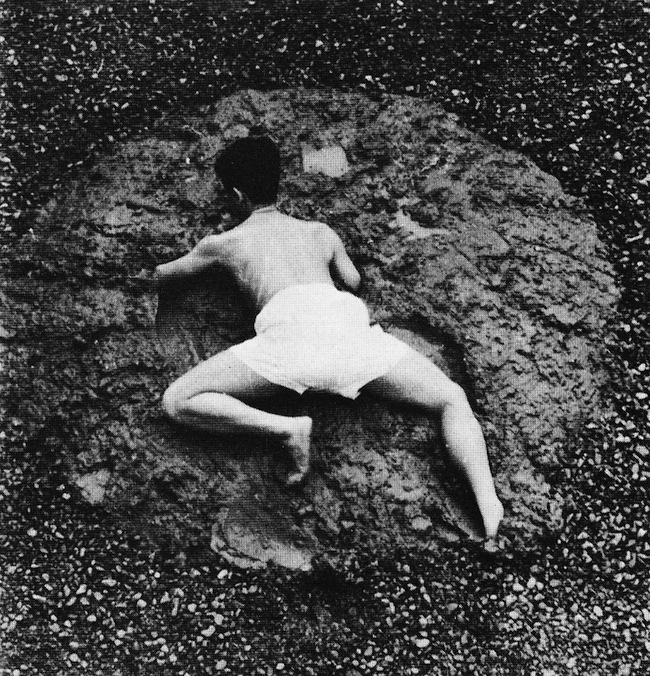The Dominique Lévy Gallery in New York City is showcasing the work of two Japenese artists (one from paint, another from ceramics) who used their bodies to leave their unique imprint on their respective mediums. Body and Matter: The Art of Kazuo Shiraga and Satoru Hoshino opened Jan. 29 and will run through April 4 at the gallery’s location on Madison Avenue. The show contains 23 abstract paintings by Kazuo Shiraga along with nine works by Satoru Hoshino, a member of the postwar Japanese ceramics group Sodeisha (the “Crawling through Mud Association”). This is the first time the two artists have had works presented in dialogue with one another.

Above images: Kazuo Shiraga, Challenging Mud, 1955, photographs of performance piece
From the Gallery:
Kazuo Shiraga emerged as one of the most prominent members of the avant-garde group Gutai with his sensational 1955 performance Challenging Mud. In a work that has become one of the canonical touchstones of postwar Japanese art as well as performance art, Shiraga used his entire body to aggressively manipulate a plot of mud, enacting a struggle between the human body and matter. The formless wall mud (kabetsuchi) used in Challenging Mud was made of cement, gravel, clay, plaster, pebbles, and twigs, and constituted a site of destruction against which the artist violently engaged his body. Through the various performances of Challenging Mud, Shiraga suffered physical injury in order to foreground the possible creative potential of destruction. He emerged from performances of Challenging Mud completely covered in congealing and caking material, ultimately obfuscating the line between his own body and the indexical marks made in the mud by his forceful movements.

Body and Matter installation view.
This performance emerged out of Shiraga’s “foot painting” practice, a radical mode he developed to express himself more fully. Shiraga set a canvas on the floor of his studio and, suspending his body from the ceiling for support, used his feet to paint powerful and energetic abstract forms. The artist continued to paint in this manner for the majority of his career, and Body and Matter: The Art of Kazuo Shiraga and Satoru Hoshino includes these important foot paintings. Displayed in a Western context, these canvases challenge preexisting notions of artistic creation and the verticality assumed in the act of painting to emphasize the corporeal meeting of body and matter.

Kazuo Shiraga, Tenkosei Kaosho, 1962
Shiraga engaged in the historical Japanese techniques of painting with the body rather than brushes (as finger-painting is a centuries-old technique developed in China) and laying the canvas directly on the floor. Introduced in a Western context, these techniques take on the valence of cultural reclaiming in the face of global modernism.
Satoru Hoshino’s ceramics similarly explore the visceral and nonhierarchical relationship between the body of the artist and matter. Hoshino has spoken of his artistic practice as an act of “baptism by… a wave of muddy water”: the body of the sculptor, rather than shaping and sublimating clay, is subsumed by the base materiality of mud and dirt. A prominent member of the avant-garde Sodeisha ceramics group from 1974 to 1980, Hoshino, along with fellow members of the group such as Yamada Hikaru (1924- 2001) and Suzuki Osamu (1926-2001), questioned virtually all the conventions of ceramic materials, form, decoration, and function, and he addressed broader issues of presentation, social hierarchy, and the political role of art.
After a landslide destroyed his studio in 1986, the artist experienced fresh revelations about the physicality and force of his material, and was inspired to work in a less controlled manner with it. Hoshino roughly shapes his sculptures by prodding and pushing clay with his fingers, and says of this process, “the finger mark is pushed to the clay unconsciously… [and so] the various elements that are in the body are put in the clay… there is no will to make a specific form.” Hoshino’s ceramics are often comprised of hundreds of finger marks, imprinted in the clay via a fierce, pulsating motion, assembled and reassembled without the orientation established by a potter’s wheel or the traditional vessel form dictated by function. In works such as Beginning Form with Spiral on view in Body and Matter Hoshino allows the clay to form and coil without any aesthetic preconceptions and the artist’s intervention in the traditional sense.
Any thoughts about this post? Share yours in the comment box below.

Kazuo Shiraga in the process of foot painting.





Ceramic works by Satoru Hoshino.

Satoru Hoshino in the studio.


Kazuo Shiraga, Challenging Mud, 1955, photographs of performance piece

UGH!